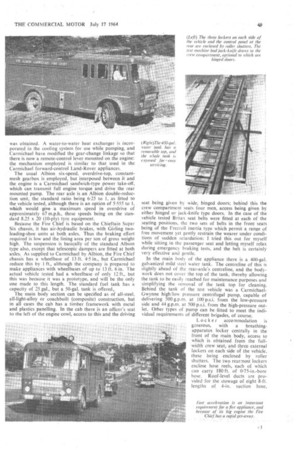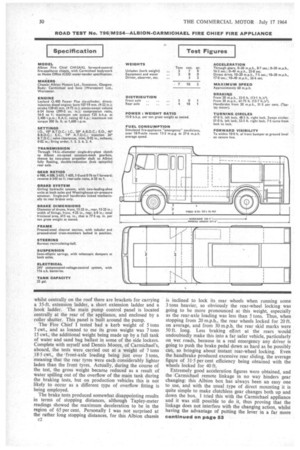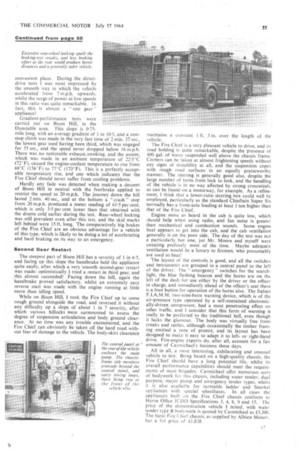Lively, Exhilarating, Unusual
Page 50

Page 51

Page 52

Page 55

If you've noticed an error in this article please click here to report it so we can fix it.
Fire Chief fire appliance GOOD handling and ease of control are possibly the most sought-after qualities for racing and sports cars, but rarely do these points count for a lot in the commercial-vehicle field, despite the need to make life as easy as possible for the driver. Admittedly, vehicle manufacturers do aim for good handling and so forth, but the purchaser is usually more interested in fuel economy and general reliability. A fire appliance is a completely different kettle of fish, however, and it is of vital importance that this class of vehicle should not only be fast and lively, but also highly manoeuvrable, stable and so simple to drive and get accustomed to that virtually any fireman holding a driving licence can get into the driving seat and control the vehicle competently under difficult traffic conditions and at high speed.
Although fire appliances do not often come my way for test, I have handled one or two in my time, but the most pleasant to drive and the one having the most simple chassis specification of the lot—that has passed through my hands has been the Albion-Carmichael Fire Chief, which consists of a semi-special Chieftain chassis built by Albion Motors Ltd., Glasgow, and bodywork by Carmichael and Sons (Worcester) Ltd., Worcester. Although a comparatively light vehicle, the Fire Chief falls into the heavy-duty class of appliance, but because there is nothing particularly complicated about it, its price is highly competitive, and it should meet the needs of brigades for whom medium-duty tenders and appliances are on the light side, yet the really heavy-duty machines are a bit too expensive.
My test of the Fire Chief showed the ability to reach 40 m.p.h. from a standstill in an average time of 25-8 sec., whilst the same speed could be reached from 10 m.p.h. in direct drive in 26-6 sec. These figures were obtained at a
til6 gross weight of just under 8 tons, and at this weight the maximum speed was found to be 60 m.p.h., whilst a simulated "emergency" run over an 1.8-9-mile route, during which various stops and rapid accelerations were made, produced a consumption rate of 13-2 m.p.g. for an average speed of 37-6 m.p.h. Fuel economy is not a prime requirement with most fire appliances—speed and agility being of far greater importance—but if fuel costs can be brought down to a minimum, no brigade is going to complain providing performance and ease of starting are not lost A brief description of the Fire Chief appliance was published in our April 17 issue, from which it will be recalled that the chassis is basically an Albion Chieftain Super Six, but with the normal Leyland 0.370 110-b.h.p. diesel engine replaced by the 0.400 unit, which develops 125 b.h.p. at 2,400 r.p.m. and 300 lb. ft. torque at 1,600 r.p.m. As these two engines are related, their sizes and weights are similar, so no serious chassis problems arose from the conversion, whilst at the same time a power increase of 13-6 per cent
was obtained. A water-to-water heat exchanger is incorporated in the cooling system for use while pumping, and Carmichael have modified the gear-change linkage so that there is now a remote-control lever, mounted on the engine: the mechanism employed is similar to that used in the Carmichael forward-control Land-Rover appliances.
The usual Albion six-speed, overdrive-top, constantmesh gearbox is employed, but interposed between it and the engine is a Carmichael sandwich-type power take-off. which can transmit full engine torque and drive the rear mounted pump. The rear axle is an Albion double-reduction unit, the standard ratio being 6.25 to I, as fitted to the vehicle tested, although there is an option of 5-555 to 1, which would give a maximum speed in overdrive of approximately 67 m.p.h., these speeds being on the standard 8.25 x 20 (10-ply) tyre equipment.
Because the Fire Chief is based on the Chieftain Super Six chassis, it has air-hydraulic brakes, with Girling twoleading-shoe units at both axles. Thus the braking effort required is low and the lining area per ton of gross weight high. The suspension is basically of the standard Albion type also, except that telescopic dampers are fitted at both axles. As supplied to Carmichael by Albion, the Fire Chief chassis has a wheelbase of 13 ft. +5 in., but Carmichael reduce this by 1 ft., although the company is prepared to make appliances with wheelbases of up to 13 ft. 6 in. The actual vehicle tested had a wheelbase of only 12 ft., but this was because it was a prototype, and will be the only one made to this length. The standard fuel tank has a capacity of 25 gal., but a 50-gal. tank is offered, The main body section can be specified as of all-steel, all-light-alloy or coachbuilt (composite) construction, but in all cases the cab has a timber framework with metal and plastics panelling. In the cab there is an officer's seat to the left of the engine cowl, access to this and the driving seat being given by wide, hinged doors; behind this the crew compartment seats four men, access being given by either hinged or jack-knife type doors. In the case of the vehicle tested Britax seat belts were fitted at each of the seating positions, the two sets of belts in the front seats being of the Freeroff inertia type which permit a range of free movement yet gently restrain the wearer under conditions of sudden retardation: I tried this out for myself while sitting in the passenger seat and letting myself relax during emergency braking tests, and the belt is certainly very effective and gentle.
In the main body of the appliance there is a 400-gal. galvanized mild ,steel water tank. The centreline of this is slightly ahead of the rear-axle's centreline, and the bodywork does not cover the top of the tank, thereby allowing the tank to be easily reached for maintenance purposes and simplifying the removal of the tank top for cleaning. Behind the tank of the test vehicle was a CarmichaelGwynne high/low pressure centrifugal pump, capable of delivering 500 g.p.m. at 100 p.s.i. from the low-pressure side and 44 g.p.m. at 500 psi. from the high-pressure outlet. Other types of pump can be fittedto meet the individual requirements of different brigades, of course.
Locker accommodation is generous, with a breathingapparatus locker centrally in the front of the main body, access to which is obtained from the fullwidth crew seat, and three external lockers on each side of the vehicle. these being enclosed by roller shutters. The two rearmost lockers enclose hose reels, each of which can carry 180 ft. of 0.75-in.-bore hose. Roof-level ducts are provided for the stowage of eight 8-ft. lengths of 4-in. suction hose,
whilst centrally on the roof there are brackets for carrying a 35-ft, extension ladder, a short extension ladder and a hook ladder. The main pump control panel is located centrally at the rear of the appliance, and enclosed by a roller shutter. This panel is built around the pump.
The Fire Chief I tested had a kerb weight of 5 tons 7 cwt., and as loaned to me its gross weight was 7 tons 15 cwt., the additional weight being made up by a full tank of water and sand bag ballast in some of the side lockers. Complete with myself and Dennis Moore, of Carmichael's, aboard, the tests were carried out at a weight of 7 tons 18.5 cwt., the /front-axle loading being just over 3 tons, Meaning that the rear tyres were each considerably lighter laden than the front tyres. Actually, during the course of the test, the gross weight became reduced as a result of water spilling out of the overflow of the main tank during the braking tests, but on production vehicles this is not likely to occur as a different type of overflow fitting is being employed.
The brake tests produced somewhat disappointing results in terms of stopping distances, although Tapley-meter readings showed the maximum deceleration to be in the region of 65 per cent. Personally I was not surprised at the rather long stopping distances, for this Albion chassis c2 is inclined to lock its rear wheels when running some 3 tons heavier, so obviously the rear-wheel locking was going to be more pronounced at this weight, especially as the rear-axle loading was less than 5 tons. Thus, when stopping from 20 m.p.h., the rear wheels locked for 20 ft. on average, and from 30 m.p.h. the rear skid marks were 50 ft. long. Less braking effort at the rears would undoubtedly make this into a far safer vehicle, particularly on wet roads, because in a real emergency any driver is going to push the brake pedal down as hard as he possibly can, so bringing about instant rear-wheel locking. Even the handbrake produced excessive rear sliding, the average figure of 31.5 per cent efficiency being obtained with the wheels locked for 40 ft.
Extremely good acceleration figures were obtained, and the Carmichael remote linkage in no way hinders gear changing: this Albion box has always been an easy one to use, and with the usual type of direct mounting it is quite simple to make clutchless gear changes both up and down the box. I tried this with the Carmichael appliance and it was still possible to do it, thus proving that the linkage does not interfere with the changing action, whilst having the advantage of putting the lever in a far more continued on page 53 convenient place. During the directdrive tests I was most impressed by the smooth way in which the vehicle accelerated from 7 m.p.h, upwards, whilst the surge of power at low speeds in this ratio was quite remarkable. In fact, this is almost a " one gear appliance!
Gradient-perfdrmance tests were carried out on Bison Hill, in the Dunstable area. This slope is 0-75mile long, with an average gradient of 1 in 10-5, and a nonstop climb was made in the very fast time of 2 min, 37 sec., the lowest gear used having been third, which was engaged for 55 sec., and the speed never dropped below 16 m.p.h. There was no noticeable exhausLsmoking, and the ascent, which was made in an ambient temperature Of 22-5°C (72°F), caused the engine-coolant temperature to rise from 69°C (156°F) to 77°C (170°F). This is a perfectly acceptable temperature rise, and one which indicates that the Fire Chief should never suffer from cooling problems.
Hardly any fade was detected when making a descent of Bison Hill in neutral with the footbrake applied to restrict the speed to 20 m.p.h. The journey down the hill lasted 2 min. 40 sec., and at the bottom a "crash" stop from 20 m.p.h. produced a meter reading of 61-5 per cent, which is only 3-5 per cent lower than that obtained with the drums cold earlier during the test. Rear-wheel locking was still prevalent even after this test, and the skid marks left behind were 15 ft. long. The comparatively big brakes of the Fire Chief are an obvious advantage for a vehicle of this type, which is likely to be doing a lot of accelerating and hard braking on its way to an emergency.
Second Gear Restart
The steepest part of Bison Hill has a severity of 1 in 6-5, and facing up this slope the handbrake held the appliance quite easily, after which a very smooth second-gear restart was made: optimistically I tried a restart in third gear, and this almost succeeded! Facing down the hill, again the handbrake proved satisfactory, whilst an extremely easy reverse start was made with the engine running at little more than idling speed.
While on Bison Hill, I took the Fire Chief up to some rough ground alongside the road, and reversed it without any, difficulty up a slope of about 1 in 7 severity, after which various hillocks were surmounted to assess the degree of suspension articulation and body ground clearance. At no time was any trouble encountered, and the Fire Chief can obviously be taken off the hard road without fear of damage to the vehicle. The body-skirt clearance maintains a constant 1 ft. 3 in. over the length of the vehicle.
The Fire Chief is a very pleasant vehicle to drive, and its road holding is quite remarkable, despite the presence of 400 gal. of water suspended well above the chassis frame. Corners can be taken at almost frightening speeds without any signs of instability at all, and the suspension copes with rough road surfaces in an equally praiseworthy manner. The steering is generally good also, despite the large number of turns from lock to lock, and the handling of the vehicle is in no way affected by strong crosswinds. as can be found on a motorway, for example. As a refinement, I think that a lower-ratio steering box could well he employed, particularly as the standard Chieftain Super Six normally has a front-axle loading at least I ton higher than that of the Fire Chief.
Engine noise as heard in the cab is quite low, which should .help when using radio, and fan noise is greater than mechanical and combustion sounds. Some engine heat appears to get into the cab, and the cab ventilation generally is on the poor side. The day of the test was not a particularly hot one, yet Mr. Moore and myself were sweating profusely most of the time. Maybe adequate ventilation would be a luxury to firemen, who presumably are used to heat!
The layout of the controls is good, and all the switches and instruments are grouped in a central panel to the left of the driver. The emergency" switches for the searchlight, the blue flashing beacon and the horns are on the left of the dash for use either by the driver or the officer in charge, and immediately ahead of the officer's seat there is a foot button for operation of the horns also. The Italian F.1.A.M.M. two-tone-horn warning device, which is of the air-pressure type operated by a self-contained electronically-driven compressor, had a most penetrating effect on other -traffic, and I consider that this form of warning is really to be preferred to the traditional bell, even though it lacks the glamour. The body was virtually free from creaks and rattles, although occasionally the timber framing emitted a note of protest, and its layout has been designed to make it easy to adapt it to leftor right-hand drive. Fire-engine exports do, after all, account for a fair
• amount of Carmichael's business these days.
All in all, a most interesting, exhilarating and unusual vehicle to test. Being based on a high-quality chassis, the Fire Chief should have a long potential life, whilst its overall performance capabilities should meet the requirements of most brigades. Carmichael offer numerous sorts of bodywork for this chassis, including water tender, dual purpose, major pump and emergency tender types, whilst it is also available for turntable ladder and Snorkel apcliances with special wheelbases. In all cases the appliances built on the Fire Chief chassis conform to Home Office JCDD Specifications 3, 4, 8, 9 and 15. The price of the demonstration vehicle I tested, with water tender type B bodywork is quoted by Carmichael as £5,300. The basic Fire Chief chassis, as supplied by Albion Motor,. has a list price of £1,8J8.
















































































































